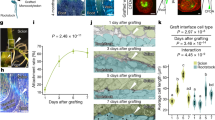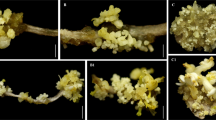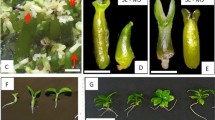Abstract
Plant regeneration from totipotent cultured cells or protoplasts is a prerequisite for the often proposed genetic modification of plants through somatic cell genetics, and has been achieved in many species. The cereals (and the rest of the Gramineae) have, however, proved to be extremely unresponsive to in vitro culture techniques1. The most convenient source of plant protoplasts is the leaf tissue because it allows the isolation of a large, relatively uniform cell population without the necessity of killing the plant. However, despite considerable efforts, sustained cell division has never been obtained from cereal leaf blade protoplasts2. Thus, a crucial question arises of whether leaf cells from cereals are actually totipotent and consequently, whether they can be useful for somatic cell genetics. We now report that young leaf tissue of a cereal can express totipotency even to the extent of forming somatic embryos. However, the ability to respond is rapidly lost during leaf maturation. We think that this phenomenon can explain many difficulties faced in cereal tissue culture. Moreover, the leaf culture we describe may help to ascertain whether mature cereal cells are merely no longer competent (in the sense of Halperin3) to respond to tested in vitro conditions or whether they actually lose their totipotency.
This is a preview of subscription content, access via your institution
Access options
Subscribe to this journal
Receive 51 print issues and online access
$199.00 per year
only $3.90 per issue
Buy this article
- Purchase on Springer Link
- Instant access to full article PDF
Prices may be subject to local taxes which are calculated during checkout
Similar content being viewed by others
References
Thomas, E., King, P. J. & Potrykus, L. Z. PflZücht. 82, 1–30 (1979).
Potrykus, I. in Advances in Protoplast Research (eds Ferenczy, L. & Farkas, G. L.) 243–254 (Pergamon, Oxford, and Akademiai Kiado, Budapest, 1980).
Halperin, W. A. Rev. Pl. Physiol. 20, 395–418 (1969).
Thomas, E., King, P. J. & Potrykus, I. Naturwissenschaften 64, 587 (1977).
Brettell, R., Wernicke, W. & Thomas, E. Protoplasma (in the press).
Murashige, T. & Skoog, F. Physiol. Pl. 15, 473–497 (1962).
King, P. J., Potrykus, I. & Thomas, E. Physiol. Veg. 16, 381–399 (1978).
Sharman, B. C. Ann. Bot. 6, 245–284 (1942).
Kaufmann, P. B. Phytomorphology 9, 277–311 (1959).
Thomas, E., Brettel, R. & Wernicke, W. in Advances in Protoplast Research (eds Ferenczy, L. & Farkas, G. L.) 269–273 (Pergamon, Oxford, and Akademiai Kiado, Budapest, 1980).
Wu, L. & Li, H. W. Cytologia 36, 411–416 (1971).
Saalbach, G. & Koblitz, H. Pl. Sci. Lett. 13, 165–169 (1978).
O'Hara, J. F. & Street, H. E. Ann. Bot. 42, 1029–1038 (1978).
Author information
Authors and Affiliations
Rights and permissions
About this article
Cite this article
Wernicke, W., Brettell, R. Somatic embryogenesis from Sorghum bicolor leaves. Nature 287, 138–139 (1980). https://doi.org/10.1038/287138a0
Received:
Accepted:
Issue Date:
DOI: https://doi.org/10.1038/287138a0
This article is cited by
-
Promoting genotype-independent plant transformation by manipulating developmental regulatory genes and/or using nanoparticles
Plant Cell Reports (2023)
-
Use of Sorghum bicolor leaf whorl explants to expedite regeneration and increase transformation throughput
Plant Cell, Tissue and Organ Culture (PCTOC) (2020)
-
Efficient regeneration system from rye leaf base segments
SpringerPlus (2016)
-
Efficient regeneration system from wheat leaf base segments
Biologia plantarum (2006)
-
Regeneration from leaf-base explants of Lolium perenne L. and Lolium multiflorum L.
Plant Cell, Tissue and Organ Culture (2005)
Comments
By submitting a comment you agree to abide by our Terms and Community Guidelines. If you find something abusive or that does not comply with our terms or guidelines please flag it as inappropriate.



